High Resolution Estimation of Ocean Dissolved Inorganic Carbon, Total Alkalinity and pH Based on Deep Learning
Abstract
:1. Introduction
2. Materials and Methods
2.1. Study Area
2.2. Field Data
2.2.1. In Situ Observations of the Carbonate System
2.2.2. Remote Sensing Data and Reanalysis Data
2.2.3. Justification for the Selection and Use of Environmental Drivers
- Kinetic forcing, by looking at atmospheric stability (proxies, such as transfer velocity, that affect the partial pressure of CO2 (pCO2), wind speed, wind direction, and wind stress on the ocean surface);
- Thermohaline forcing, by looking at proxies such the sea surface temperature and the sea surface salinity;
- Biological forcing, by looking at proxies such as chlorophyll-a, surface reflectance and its ratios, and particulate organic and inorganic carbon and its ratios;
- Water-side convection and upwelling, by looking at proxies such as mixing layer depth and bathymetry.
2.3. Algorithm Development and Validation
2.3.1. Training of the ANN
- The collection of co-located and co-temporal input (i.e., independent environmental drivers) and co-located and co-temporal output (i.e., cruise measurements of DIC, TA, and pH) datasets;
- The data were normalized and scaled to the range of 0 to 1 to suit the transfer function in the hidden (sigmoidal, discrete; logistical implementation) and output layer (linear):  = (A − Amin)/(Amax − Amin), where  is the normalized value and Amin and Amax are the minimum and maximum values of A, respectively;
- Neural network designing and training;
- The testing of the ANN topology.
- A large number of iterations was used (circa 10,000) in order to minimize the processing error of the training set as much as possible. The training was stopped when a very small and stable training error was achieved (circa 0.0007);
- The number of learning samples consisted of entire sets of measurements spanning the northwestern Atlantic, with its inherent physical (including bathymetry, surface salinity, winds, wind stress, temperature, and mixed layer depths) and biological (chlorophyll-a, dissolved organic carbon, and surface-leaving reflectance) parameters, in order to model the highest possible scenario for appropriate learning under a wide range of variability. This training procedure can be further improved by including input and output variables with a greater degree of variability, such as measurements covering other regional areas and time periods;
- An optimal number of hidden units (n = 5) was found with the sigmoid activation function and a liner output unit to derive an optimal ‘expressive’ power of the network. The present training set presented a ‘smooth’ function and therefore the number of hidden units needed was kept to a minimum (n = 5). For strongly fluctuating functions, more hidden units are generally needed, which does not seem to be a requirement for our study.
2.3.2. Performance of the BPN Algorithm
2.4. Construction of Gridded DIC, TA, and pH Gridded Data for 30 October 2016
3. Results and Discussion
3.1. Validation between Remotely Sensed- and Cruise-Derived SST and SSS Data
3.2. Performance of the BPN Algorithm
3.2.1. M/V Equinox—7–8 March 2015
3.2.2. M/V Equinox—30 October to 6 November 2016, North Atlantic Ocean (20° N to 40° N; −80° W to −10° W)
- The further training of the BNP algorithm. In so doing, the training process of the BNP algorithm should allow for further ‘learning’ from the local/regional variability of both the predictors and predictands;
- Although the neural networks have the ability to ‘generalize’, the additional retrieval of in situ measurements of surface DIC, TA, and pH from cruises can be carried out during other seasons over the same area, and combining this with the training set that was used for the BNP algorithm might prove useful;
- Expand the range of predictors (i.e., environmental drivers; see Section 3.3.2 below).
3.3. Model Applications: ANN-Derived Ocean Variability of DIC, TA, and pH over the Mid-North Atlantic Ocean
3.3.1. Validation of the Modeled Data over the Mid-North Atlantic Ocean
- In Situ Cruise Data
- Hindcast Biochemistry Data
3.3.2. Caveats and Recommendations
4. Conclusions
Author Contributions
Funding
Institutional Review Board Statement
Informed Consent Statement
Data Availability Statement
Acknowledgments
Conflicts of Interest
References
- Feely, R.A.; Orr, J.; Fabry, V.J.; Kleypas, J.A.; Sabine, C.L.; Langdon, C. Present and Future Changes in Seawater Chemistry Due to Ocean Acidification. In Carbon Sequestration and Its Role in the Global Carbon Cycle; American Geophysical Union: Washington, DC, USA, 2009; Volume 183, pp. 5–8. [Google Scholar] [CrossRef]
- Bakker, D.C.E.; Pfeil, B.; O’Brien, K.M.; Currie, K.I.; Jones, S.D.; Landa, C.S.; Lauvset, S.K.; Metzl, N.; Munro, D.R.; Nakaoka, S.; et al. Surface Ocean CO2 Atlas (SOCAT) V4. Pangaea 2016. [CrossRef]
- Sabine, C.L.; Hankin, S.; Koyuk, H.; Bakker, D.C.E.; Pfeil, B.; Olsen, A.; Metzl, N.; Kozyr, A.; Fassbender, A.; Manke, A.; et al. Multispectral Remote Sensing Algorithms for Particulate Organic Carbon (POC): The Gulf of Mexico. Remote Sens. Environ. 2009, 113, 50–61. [Google Scholar] [CrossRef] [Green Version]
- Lauvset, S.K.; Lange, N.; Tanhua, T.; Bittig, H.C.; Olsen, A.; Kozyr, A.; Álvarez, M.; Becker, S.; Brown, P.J.; Carter, B.R.; et al. An updated version of the global interior ocean biogeochemical data product, GLODAPv2.2021. Earth Syst. Sci. Data 2021, 13, 5565–5589. [Google Scholar] [CrossRef]
- Tanhua, T.; Orr, J.C.; Lorenzoni, L.; Hansson, L. Monitoring ocean carbon and ocean acidification. WMO Bull. 2015, 64, 48–51. [Google Scholar]
- NRDC. Ocean Acidification Hotspots. Natural Resources Defence Council. 2022. Available online: https://www.nrdc.org/resources/ocean-acidification-hotspots (accessed on 24 September 2022).
- Zeng, J.; Matsunaga, T.; Saigusa, N.; Shirai, T.; Shin-Ichiro, N.; Zheng-Hong, T. Technical note: Evaluation of three machine learning models for surface ocean CO2 mapping. Ocean Sci. 2017, 13, 303–313. [Google Scholar] [CrossRef] [Green Version]
- Jiang, Z.; Song, Z.; Bai, Y.; He, X.; Yu, S.; Zhang, S.; Gong, F. Remote Sensing of Global Sea Surface pH Based on Massive Underway Data and Machine Learning. Remote Sens. 2022, 14, 2366. [Google Scholar] [CrossRef]
- Bittig, H.C.; Steinhoff, T.; Claustre, H.; Fiedler, B.; Williams, N.L.; Sauzède, R.; Körtzinger, A.; Gattuso, J.P. An alternative to static climatologies: Robust estimation of open ocean CO2 variables and nutrient concentrations from T, S, and O2 data using bayesian neural networks. Front. Mar. Sci. 2018, 5, 328. [Google Scholar] [CrossRef]
- Hall, E.R.; Wickes, L.; Burnett, L.E.; Scott, G.I.; Hernandez, D.; Yates, K.K.; Barbero, L.; Reimer, J.J.; Baalousha, M.; Mintz, J.; et al. Acidification in the U.S. Southeast: Causes, Potential Consequences and the Role of the Southeast Ocean and Coastal Acidification Network. Front. Mar. Sci. 2020, 7, 548. [Google Scholar] [CrossRef]
- Ekstrom, J.; Suatoni, L.; Cooley, S.; Pendleton, L.H.; Waldbusser, G.G.; Cinner, J.E.; Ritter, J.; Langdon, C.; Van Hooidonk, R.; Gledhill, D.; et al. Vulnerability and adaptation of US shellfisheries to ocean acidification. Nat. Clim. Change 2015, 5, 207–214. [Google Scholar] [CrossRef]
- Burgos, M.; Sendra, M.; Ortega, T.; Ponce, R.; Gómez-Parra, A.; Forja, J.M. Ocean-Atmosphere CO2 Fluxes in the North Atlantic Subtropical Gyre: Association with Biochemical and Physical Factors during Spring. J. Mar. Sci. Eng. 2015, 3, 891–905. [Google Scholar] [CrossRef]
- Rérolle, V.M.C.; Achterberg, E.P.; Ribas-Ribas, M.; Kitidis, V.; Brown, I.; Bakker, D.C.; Lee, G.A.; Mowlem, M.C. High-resolution pH measurements using a lab-on-chip sensor in surface waters of northwest European shelf seas. Sensors 2018, 18, 2622. [Google Scholar] [CrossRef] [Green Version]
- Palevsky, H.I.; Quay, P.D. Influence of biological carbon export on ocean carbon uptake over the annual cycle across the North Pacific Ocean. Glob. Biogeochem. Cycles 2017, 31, 81–95. [Google Scholar] [CrossRef] [Green Version]
- Liu, M.; Tanhua, T. Water masses in the Atlantic Ocean: Characteristics and distributions. Ocean Sci. 2021, 17, 463–486. [Google Scholar] [CrossRef]
- Vázquez-Rodríguez, M.; Touratier, F.; Lo Monaco, C.; Waugh, D.; Padin, X.A.; Bellerby, R.G.J.; Goyet, C.; Metzl, N.; Ríos, A.F.; Pérez, F.F. Anthropogenic carbon in the Atlantic Ocean: Comparison of four data-based calculation methods. Biogeosciences 2009, 6, 439–451. [Google Scholar] [CrossRef] [Green Version]
- Khatiwala, S.; Tanhua, T.; Mikaloff Fletcher, S.; Gerber, M.; Doney, S.C.; Graven, H.D.; Gruber, N.; McKinley, G.A.; Murata, A.; Ríos, A.F.; et al. Global ocean storage of anthropogenic carbon. Biogeosciences 2013, 10, 2169–2191. [Google Scholar] [CrossRef] [Green Version]
- Lauvset, S.K.; Gruber, N.; Landschützer, P.; Olsen, A.; Tjiputra, J. Trends and drivers in global surface ocean pH over the past 3 decades. Biogeosciences 2015, 12, 1285–1298. [Google Scholar] [CrossRef] [Green Version]
- Bates, N.R.; Best, M.H.P.; Neely, K.; Garley, R.; Dickson, A.G.; Johnson, R.J. Detecting Anthropogenic Carbon Dioxide Uptake and Ocean Acidification in the North Atlantic Ocean. Biogeosciences 2012, 9, 2509–2522. [Google Scholar] [CrossRef] [Green Version]
- NOAA. State of the Climate: Ocean Heat Storage. 2015. Available online: https://www.climate.gov/news-features/featured-images/2015-state-climate-ocean-heat-storage (accessed on 24 September 2022).
- NOAA. Reporting on the State of the Climate in 2016. Available online: https://www.ncei.noaa.gov/news/reporting-state-climate-2016 (accessed on 24 September 2022).
- Clark, D.R.; Flynn, K.J. The Relationship between the Dissolved Inorganic Carbon Concentration and Growth Rate in Marine Phytoplankton. Proc. Biol. Sci. 2000, 267, 953–959. Available online: https://www.jstor.org/stable/1571440 (accessed on 22 August 2022). [CrossRef] [Green Version]
- Barbero, L.; Wanninkhof, R.; Pierrot, D. Dissolved Inorganic Carbon, Total Alkalinity, pH, and Other Variables Collected from Surface and Discrete Observations Using Flow-Through Pump and Other Instruments from M/V Equinox in the North Atlantic Ocean from 2015-03-07 to 2016-11-06 (NCEI Accession 0154382); Dataset; NOAA National Centers for Environmental Information: Washington, DC, USA, 2016. [Google Scholar] [CrossRef]
- Ioannou, I.; Gilerson, A.; Gross, B.; Moshary, F.; Ahmed, S. Deriving ocean color products using neural networks. Remote Sens. Environ. 2013, 134, 78–91. [Google Scholar] [CrossRef]
- Stramska, M. Particulate organic carbon in the global ocean derived from SeaWIFS ocean color. Deep. Sea Res. I 2009, 56, 1459–1470. [Google Scholar] [CrossRef]
- Zhu, Y.; Shang, S.; Shai, W.; Dai, M. Satellite-derived surface water pCO2 and air-sea CO2 fluxes in the northern South China Sea in summer. Prog. Nat. Sci. 2009, 19, 775–779. [Google Scholar] [CrossRef]
- Balch, W.M.; Gordon, H.R.; Bowler, B.C.; Drapeau, D.T.; Booth, E.S. Calcium carbonate budgets in the surface global ocean based on MODIS data. J. Geophys. Res. 2005, 110, C07001. [Google Scholar] [CrossRef]
- Stramski, D.; Reynolds, R.A.; Kahru, M.; Mitchell, B.G. Estimation of particulate organic carbon in the ocean from satellite remote sensing. Science 1999, 285, 239–242. [Google Scholar] [CrossRef] [PubMed]
- Stramska, M.; Stramski, D. Variability of particulate organic carbon concentration in the north polar Atlantic based on ocean color observations with Sea-viewing Wide Field-of-view Sensor (SeaWiFS). J. Geophys. Res. 2005, 110, C10018. [Google Scholar] [CrossRef] [Green Version]
- Boutin, J.; Vergely, J.L.; Marchand, S.; D’Amico, F.; Hasson, A.; Kolodziejczyk, N.; Reul, N.; Reverdin, G.; Vialard, J. New SMOS Sea Surface Salinity with reduced systematic errors and improved variability. Remote Sens. Environ. 2018, 214, 115–134. [Google Scholar] [CrossRef] [Green Version]
- Wanninkhof, R. Relationship between wind speed and gas exchange over the ocean revisted. Limnol. Oceanogr. 2014, 12, 351–362. [Google Scholar] [CrossRef]
- Wanninkhof, R. Relationship between wind speed and gas exchange over the ocean. J. Geophys. Res. 1992, 97, 7373–7382. [Google Scholar] [CrossRef]
- Wanninkhof, R.; McGillis, W.R. A Cubic Relationship between Air-Sea CO2 Exchange and Wind Speed. Geophys. Res. Lett. 1999, 26, 1889–1892. [Google Scholar] [CrossRef]
- Iwano, K.; Takagaki, N.; Kurose, R.; Komori, S. Mass transfer velocity across the breaking air–water interface at extremely high wind speeds. Tellus B Chem. Phys. Meteorol. 2013, 65, 1. [Google Scholar] [CrossRef]
- Hall, J.K. GEBCO centennial special issue—Charting the secret world of the ocean floor: The GEBCO project 1903–2003. Mar. Geophys. Res. 2006, 27, 1–5. [Google Scholar] [CrossRef]
- Dickson, A.G.; Sabine, C.L.; Christian, J.R. Guide to Best Practices for Ocean CO2 Measurements; PICES Special Publication; NOAA: Washington, DC, USA, 2007; Volume 3, pp. 1–191. [Google Scholar]
- Turk, D.; Malacic, V.; De Grandpre, M.D.; McGillis, W.R. Carbon dioxide variability and air-sea fluxes in the northern Adriatic Sea. J. Geophys. Res. 2010, 115, C10. [Google Scholar] [CrossRef] [Green Version]
- Wanninkhof, R.; Asher, W.E.; Ho, D.T.; Sweeney, C.S.; McGillis, W.R. Advances in quantifying air-sea gas exchange and environmental forcing. Ann. Rev. Mar. Sci. 2009, 1, 213–244. [Google Scholar] [CrossRef] [Green Version]
- Macintyre, S.; Wanninkhof, R.; Chanton, J.P. Trace gas exchange across the air-water interface in freshwaters and coastal marine environments. In Biogenic Trace Gasses: Measuring Emissions from Soils and Waters; Mattson, P.A., Harris, R.C., Eds.; Blackwell: New York, NY, USA, 1995; pp. 52–57. [Google Scholar]
- Sweeney, C.; Gloor, E.; Jacobson, A.R.; Key, R.M.; McKinley, G.; Sarmiento, J.L.; Wanninkhof, R. Constraining global air–sea gas exchange for CO2 with recent bomb 14C measurements. Glob. Biogeochem. Cycles 2007, 21, GB2015. [Google Scholar] [CrossRef]
- Ho, D.T.; Law, C.S.; Smith, M.J.; Schlosser, P.; Harvey, M.; Hill, P. Measurements of air-sea gas exchange at high wind speeds in the Southern Ocean: Implications for global parameterizations. Geophys. Res. Lett. 2006, 33, L16611. [Google Scholar] [CrossRef] [Green Version]
- Fairall, C.W.; Hare, J.E.; Edson, J.B.; McGillis, W. Parameterization and Micrometeorological Measurement of Air–Sea Gas Transfer. Bound. Layer Meteorol. 2000, 96, 63–106. [Google Scholar] [CrossRef]
- Krakauer, N.Y.; Randerson, J.T.; Primeau, F.W.; Gruber, N.; Menemenlis, D. Carbon Isotope Evidence for the Latitudinal Distribution and Wind Speed Dependence of the Air–sea Gas Transfer Velocity. Tellus Ser. B Chem. Phys. Meteorol. 2006, 58, 390–417. [Google Scholar] [CrossRef] [Green Version]
- Suzuki, N.; Doneloan, M.A.; Takagaki, N.; Komori, S. Comparison of the global air-sea CO2 gas flux on the difference of transfer velocity model. J. Adv. Mar. Sci. Technol. Soc. 2015, 21, 59–63. [Google Scholar] [CrossRef]
- Boutin, J.; Quilfen, Y.; Merlivat, L.; Piolle, J.F. Global average of air-sea CO2 transfer velocity from QuikSCAT scatterometer wind speeds. J. Geophys. Res. 2009, 114, C04007. [Google Scholar] [CrossRef] [Green Version]
- Woolf, D. Bubbles and their role in gas exchange. In The Sea Surface and Global Change; Liss, P., Duce, R., Eds.; Cambridge University Press: Cambridge, UK, 1997; pp. 173–206. [Google Scholar] [CrossRef]
- Wanninkhof, R.; Knox, M. Chemical enhancement of CO2 exchange in natural waters. Limnol. Oceanogr. 1996, 41, 689–698. [Google Scholar] [CrossRef]
- McGillis, W.R.; Edson, J.B.; Zappa, C.J.; Ware, J.D.; McKenna, S.P.; Terray, E.A.; Hare, J.E.; Fairall, C.W.; Drennan, W.; Donelan, M.; et al. Air-sea CO2 exchange in the equatorial Pacific. J. Geophys. Res. 2004, 109, C08S02. [Google Scholar] [CrossRef] [Green Version]
- Zappa, C.J.; McGillis, W.R.; Raymond, P.A.; Edson, J.B.; Hintsa, E.J.; Zemmelink, H.J.; Dacey, J.W.; Ho, D.T. Environmental turbulent mixing controls on air-water gas exchange in marine and aquatic systems. Geophys. Res. Lett. 2007, 34, 28790. [Google Scholar] [CrossRef] [Green Version]
- Monahan, E.C.; Dam, H.G. Bubbles: An estimate of their role in the global oceanic flux of carbon. J. Geophys. Res. 2001, 106, 9377–9383. [Google Scholar] [CrossRef]
- McNeil, C.; D’Asaro, E. Parameterization of air–sea gas fluxes at extreme wind speeds. J. Mar. Syst. 2007, 66, 110–121. [Google Scholar] [CrossRef]
- Vogelzang, J.; Stoffelen, A.; Verhoef, A.; Figa-Saldaña, J. On the quality of high-resolution scatterometer winds. J. Geophys. Res. 2011, 116, C10033. [Google Scholar] [CrossRef] [Green Version]
- Galdies, C.; Donoghue, D.N.M. A first attempt at assimilating microwave-derived SST to improve the predictive capability of a coupled, high-resolution Eta-POM forecasting system. Int. J. Remote Sens. 2009, 30, 6169–6197. [Google Scholar] [CrossRef]
- Rutgersson, A.; Smedman, A. Enhancement of CO2 transfer velocity due to water-side convection. J. Mar. Syst. 2010, 80, 125–134. [Google Scholar] [CrossRef]
- Brostrom, G. The role of the seasonal cycles for the air–sea exchange of CO2. Mar. Chem. 2000, 72, 151–169. [Google Scholar] [CrossRef]
- Luger, H.; Wallace, D.W.R.; Kortzinger, A.; Nojiri, Y. The pCO2 variability in the midlatitude North Atlantic Ocean during a full annual cycle. Glob. Biochem. Cycles 2004, 18, GB3023. [Google Scholar] [CrossRef] [Green Version]
- Lellouche, J.-M.; Legalloudec, O.; Regnier, C.; Levier, B.; Greiner, E.; Drevillon, M. Quality Information Document for Global Sea Physical Analysis and Forecasting Product 2016. GLOBAL_ANALYSIS_FORECAST_PHY_001_024. Issue 2.0 Provided by the Copernicus Marine Environment Monitoring Service. Available online: https://hpc.niasra.uow.edu.au/dataset/550d2a5a-b66c-4318-aac2-c0fcf64370c0/resource/2d66a089-fe71-47ea-8245-6e1f1d469f59/download/global-analysis-forecast-phy-001-0241551608429013.nc (accessed on 24 September 2022).
- Zeng, J.; Nojiri, Y.; Landschützer, P.; Telszewski, M.; Nakaoka, S. A global surface ocean fCO2 climatology based on a feedforward neural network. J. Atmos. Ocean Technol. 2014, 31, 1838–1849. [Google Scholar] [CrossRef]
- Chen, S.; Hu, C.; Barnes, B.B.; Wanninkhof, R.; Cai, W.-J.; Barbero, L.; Pierrot, D. A machine learning approach to estimate surface ocean pCO2 from satellite measurements. Remote Sens. Environ. 2019, 228, 203–226. [Google Scholar] [CrossRef]
- Cosca, C.E.; Feely, R.A.; Boutin, J.; Etcheto, J.; McPhaden, M.J.; Chavez, F.P.; Strutton, P.G. Seasonal and interannual CO2 fluxes for the central and eastern equatorial Pacific Ocean as determined from fCO2-SST relationships. J. Geophys. Res. 2003, 108, 3278. [Google Scholar] [CrossRef]
- Landschützer, P.; Gruber, N.; Bakker, D.C.E.; Schuster, U.; Nakaoka, S.; Payne, M.R.; Sasse, T.P.; Zeng, J. A neural network-based estimate of the seasonal to inter-annual variability of the Atlantic Ocean carbon sink. Biogeosciences 2013, 10, 7793–7815. [Google Scholar] [CrossRef] [Green Version]
- Takahashi, T.; Olafsson, J.; Goddard, J.; Chipman, D.W.; Sutherland, S.C. Seasonal variation of CO2 and nutrients in the high-latitude surface oceans: A comparative study. Glob. Biogeochem. Cycles 1993, 7, 843–878. [Google Scholar] [CrossRef]
- Hales, B.; Takahashi, T.; Bandstra, L. Atmospheric CO2 uptake by a coastal upwelling system. Glob. Biogeochem. Cycles 2005, 19, GB1009. [Google Scholar] [CrossRef]
- Stephens, M.P.; Samuels, G.; Olson, D.B.; Fine, R.A.; Takahashi, T. Sea-air flux of CO2 in the North Pacific using shipboard and satellite data. J. Geophys. Res. 1995, 100, 13571–13583. [Google Scholar] [CrossRef]
- Ono, T.; Saino, T.; Kurita, N.; Sasaki, K. Basin-scale extrapolation of shipboard pCO2 data by using satellite SST and Chla. Int. J. Remote Sens. 2003, 25, 3803–3815. [Google Scholar] [CrossRef]
- Bates, N.R.; Takahashi, T.; Chipman, D.; Goddard, J.G.; Howse, F.; Knap, A.H. Diurnal to Seasonal Variability of pCO2 in the Sargasso Sea. Variability of PCO2 on Diel to Seasonal Timescales in the Sargasso Sea near Bermuda. J. Geophys. Res. Ocean. 1998, 1031, 15567–15586. [Google Scholar] [CrossRef]
- Watson, A.; Robinson, C.; Robinson, J.; William, P.I.B.; Fasham, M. Spatial variability in the sink for atmospheric carbon dioxide in the North Atlantic. Nature 1991, 350, 50–53. [Google Scholar] [CrossRef]
- Banzon, V.; Smith, T.M.; Chin, T.M.; Liu, C.; Hankins, W. A long-term record of blended satellite and in situ sea-surface temperature for climate monitoring, modeling and environmental studies. Earth Syst. Sci. Data 2016, 8, 165–176. [Google Scholar] [CrossRef] [Green Version]
- NOAA. What Is Upwelling? Available online: https://oceanservice.noaa.gov/facts/upwelling.html (accessed on 24 September 2022).
- Vargas, C.A.; Cuevas, L.A.; Broitman, B.R.; San Martin, V.A.; Lagos, N.A.; Gaitán-Espitia, J.D.; Dupont, S. Upper environmental pCO2 drives sensitivity to ocean acidification in marine invertebrates. Nat. Clim. Change 2022, 12, 200–207. [Google Scholar] [CrossRef]
- Duforêt-Gaurier, L.; Loisel, H.; Dessailly, D.; Nordkvist, K.; Alvain, S. Estimates of particulate organic carbon over the euphotic depth from in situ measurements. Application to satellite data over the global ocean. Deep. Sea Res. Part I Oceanogr. Res. Pap. 2010, 57, 351–367. [Google Scholar] [CrossRef]
- Findlay, H.S.; Calosi, P.; Crawfurda, K. Determinants of the PIC:POC response in the coccolithophore Emiliania huxleyi under future ocean acidification scenarios. Limnol. Oceanogr. 2011, 56, 1168–1178. [Google Scholar] [CrossRef] [Green Version]
- Ridgwell, A.; Schmidt, D.N.; Turley, C.; Brownlee, C.; Maldonado, M.T.; Tortell, P.; Young, J.R. From laboratory manipulations to Earth system models: Scaling calcification impacts of ocean acidification. Biogeosciences 2009, 6, 2611–2623. [Google Scholar] [CrossRef] [Green Version]
- Hu, C.; Lee, Z.; Franz, B. Chlorophyll-a algorithms for oligotrophic oceans: A novel approach based on three-band reflectance difference. J. Geophys. Res. 2012, 117, C01011. [Google Scholar] [CrossRef] [Green Version]
- Bryson, A.E.; Ho, Y.-C. Applied Optimal Control; Blaisdell Publishing Co.: Waltham, MA, USA, 1969. [Google Scholar]
- Rumelhart, D.E.; Hinton, G.E.; Williams, R.J. Learning representations by back-propagating errors. Nature 1986, 323, 533536. [Google Scholar] [CrossRef]
- Svozil, D.; Kvasnicka, V.; Pospichal, J. Introduction to multi-layer feed-forward neural networks. Chemom. Intell. Lab. Syst. 1997, 39, 43–62. [Google Scholar] [CrossRef]
- Bishop, C.M. Neural Networks for Pattern Recognition; Oxford University Press: New York, NY, USA, 1995. [Google Scholar]
- Chau, T.T.T.; Gehlen, M.; Chevallier, F. A seamless ensemble-based reconstruction of surface ocean pCO2 and air–sea CO2 fluxes over the global coastal and open oceans. Biogeosciences 2022, 19, 1087–1109. [Google Scholar] [CrossRef]
- Fourrier, M.; Coppola, L.; Claustre, H.; D’Ortenzio, F.; Sauzède, R.; Gattuso, J.-P. A Regional Neural Network Approach to Estimate Water-Column Nutrient Concentrations and Carbonate System Variables in the Mediterranean Sea: CANYON-MED. Front. Mar. Sci. 2020, 7, 620. [Google Scholar] [CrossRef]
- Campos Velho, H.F.; Furtado, H.C.M.; Sambatti, S.B.M.; Osthoff Ferreira de Barros, C.B.; Welter, M.E.S.; Souto, R.P.; Carvalho, D.; Cardoso, D.O. Data Assimilation by Neural Network for Ocean Circulation: Parallel Implementation. Supercomput. Front. Innov. 2022, 9, 74–86. [Google Scholar] [CrossRef]
- Irrgang, C.; Saynisch-Wagner, J.; Thomas, M. Machine Learning-Based prediction of spatiotemporal uncertainties in global wind velocity reanalyses. J. Adv. Model. Earth Syst. 2020, 12, e2019MS001876. [Google Scholar] [CrossRef] [Green Version]
- United Nations. Ocean Acidification Research on Local Scales. 2022. Available online: https://sdgs.un.org/partnerships/ocean-acidification-research-local-scales (accessed on 24 September 2022).
- Landschützer, P.; Gruber, N.; Bakker, D.C.E. Decadal variations and trends of the global ocean carbon sink. Glob. Biogeochem. Cycles 2016, 30, 1396–1417. [Google Scholar] [CrossRef] [Green Version]
- Sutton, A.J.; Feely, R.A.; Sabine, C.L.; McPhaden, M.J.; Takahashi, T.; Chavez, F.P.; Friederich, G.E.; Mathis, J.T. Natural variability and anthropogenic change in equatorial Pacific surface ocean pCO2 and pH. Glob. Biogeochem. Cycles 2014, 28, 131–145. [Google Scholar] [CrossRef]
- Kraus, E.B.; Businger, J.A. Atmosphere-Ocean Interaction; Oxford University Press: Oxford, UK, 1994; 352p. [Google Scholar]
- Galdies, C.; Garcia-Luque, E.; Guerra, R. Variability CO2 Parameters in the North Atlantic Subtropical Gyre: A Neural Network Approach; Ocean Carbon and Biogeochemistry (OCB) Summer Workshop; Woods Hole Oceanographic Institution: Falmouth, MA, USA, 2018. [Google Scholar]
- Lu, F.; Harrison, M.J.; Rosati, A.; Delworth, T.L.; Yang, X.; Cooke, W.F.; Jia, L.; McHugh, C.; Johnson, N.C.; Bushuk, M.; et al. GFDL’s SPEAR seasonal prediction system: Initialization and ocean tendency adjustment (OTA) for coupled model predictions. J. Adv. Model. Earth Syst. 2020, 12, e2020MS002149. [Google Scholar] [CrossRef]
- Hendriks, I.E.; Olsen, Y.S.; Ramajo, L.; Basso, L.; Steckbauer, A.; Moore, T.S.; Howard, J.; Duarte, C.M. Photosynthetic activity buffers ocean acidification in seagrass meadows. Biogeosciences 2014, 11, 333–346. [Google Scholar] [CrossRef] [Green Version]
- Young, C.S.; Gobler, C.J. The ability of macroalgae to mitigate the negative effects of ocean acidification on four species of North Atlantic bivalve. Biogeosciences 2018, 15, 6167–6183. [Google Scholar] [CrossRef] [Green Version]
- Cornwall, C.E.; Hepburn, C.D.; McGraw, C.M.; Currie, K.I.; Pilditch, C.A.; Hunter, K.A.; Boyd, P.W.; Hurd, C.L. Diurnal fluctuations in seawater pH influence the response of a calcifying macroalga to ocean acidification. Proc. R. Soc. B Biol. Sci. 2013, 280, 20132201. [Google Scholar] [CrossRef] [Green Version]
- Noisette, F.; Hurd, C. Abiotic and biotic interactions in the diffusive boundary layer of kelp blades create a potential refuge from ocean acidification. Funct. Ecol. 2018, 32, 1329–1342. [Google Scholar] [CrossRef] [Green Version]
- Hurd, C.L. Slow-flow habitats as refugia for coastal calcifiers from ocean acidification. J. Phycol. 2015, 51, 599–605. [Google Scholar] [CrossRef]
- Tittensor, D.P.; Baco, A.R.; Hall-Spencer, J.M.; Orr, J.C.; Rogers, A.D. Seamounts as refugia from ocean acidification for cold-water stony corals. Mar. Ecol. 2010, 31, 212–225. [Google Scholar] [CrossRef] [Green Version]
- Chan, F.; Barth, J.A.; Blanchette, C.A.; Byrne, R.H.; Chavez, F.; Cheriton, O.; Feely, R.A.; Friederich, G.; Gaylord, B.; Gouhier, T.; et al. Persistent spatial structuring of coastal ocean acidification in the California Current System. Sci. Rep. 2017, 7, 2526. [Google Scholar] [CrossRef] [Green Version]
- Kapsenberg, L.; Hofmann, G.E. Ocean pH time-series and drivers of variability along the northern Channel Islands, California, USA. Limnol. Oceanogr. 2016, 61, 953–968. [Google Scholar] [CrossRef] [Green Version]
- Kapsenberg, L.; Cyronak, T. Ocean acidification refugia in variable environments. Glob. Change Biol. 2019, 25, 3201–3214. [Google Scholar] [CrossRef] [PubMed] [Green Version]



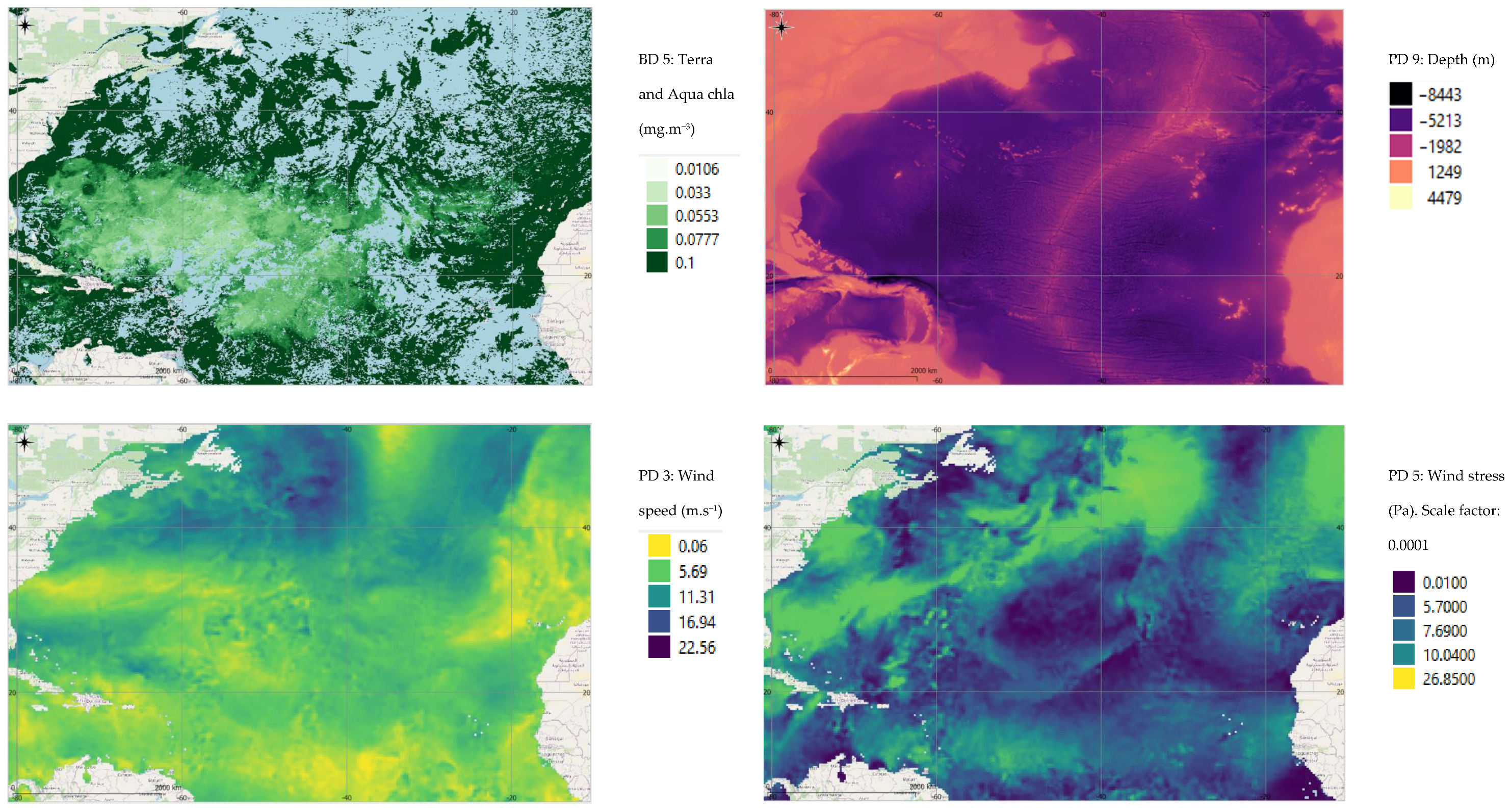
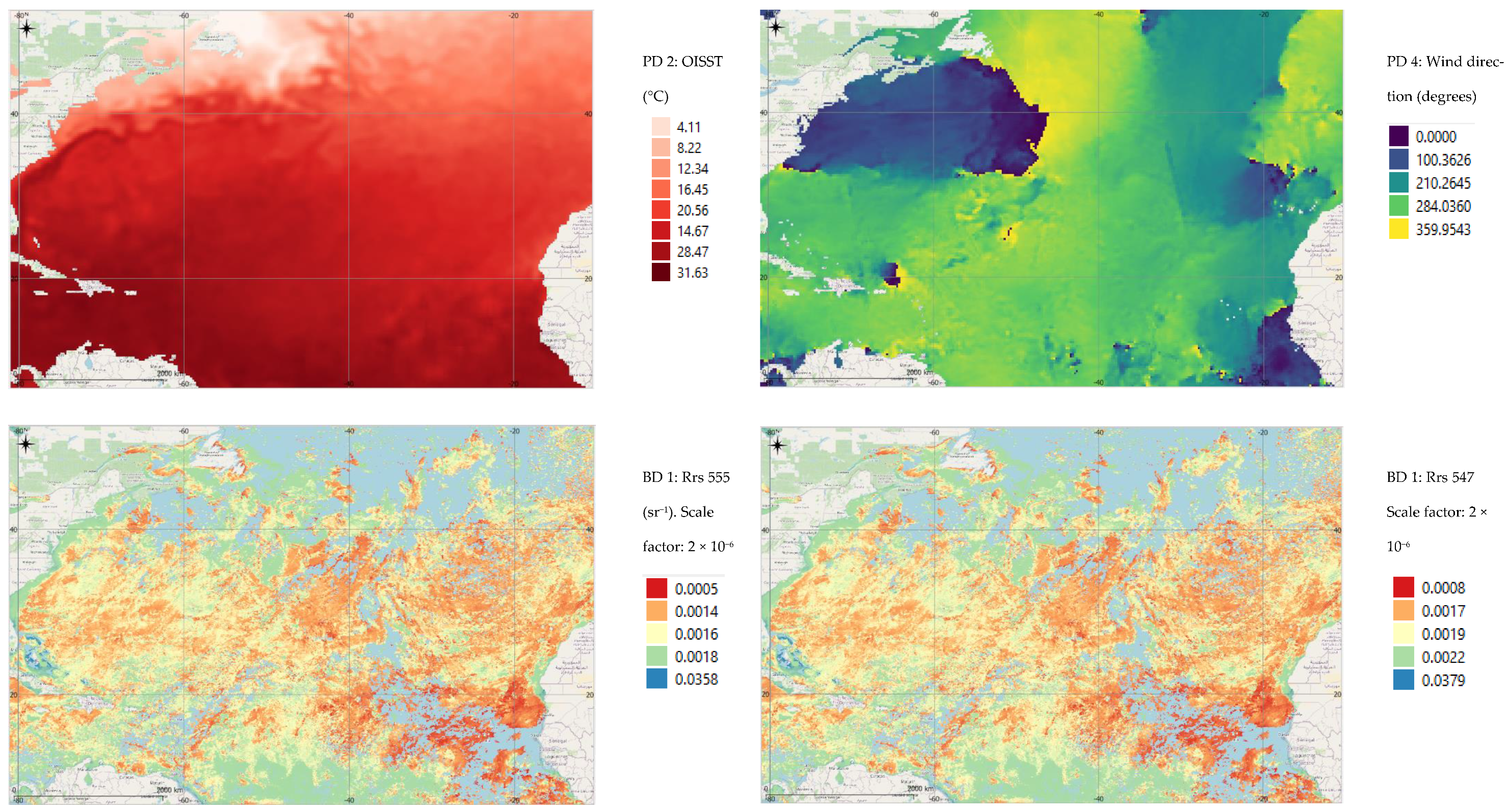

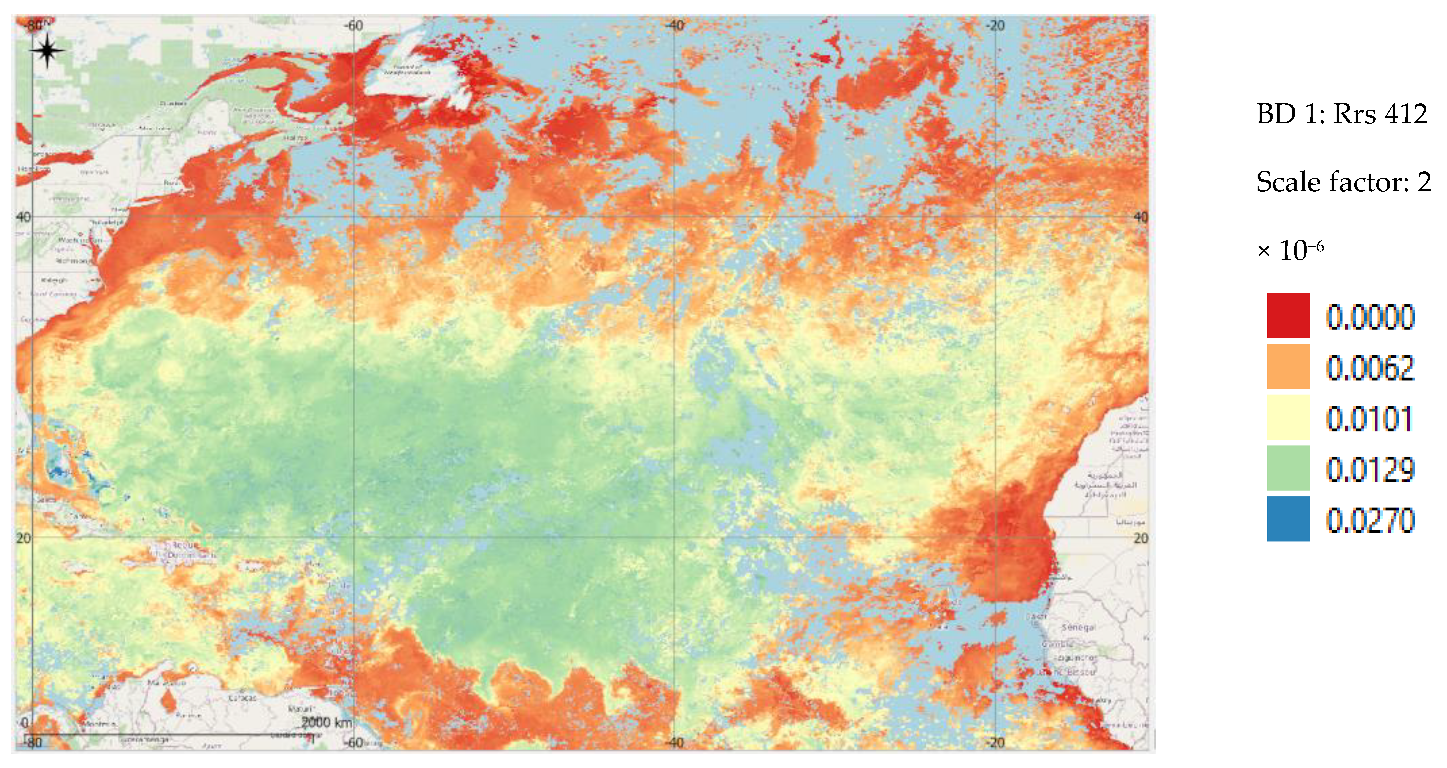
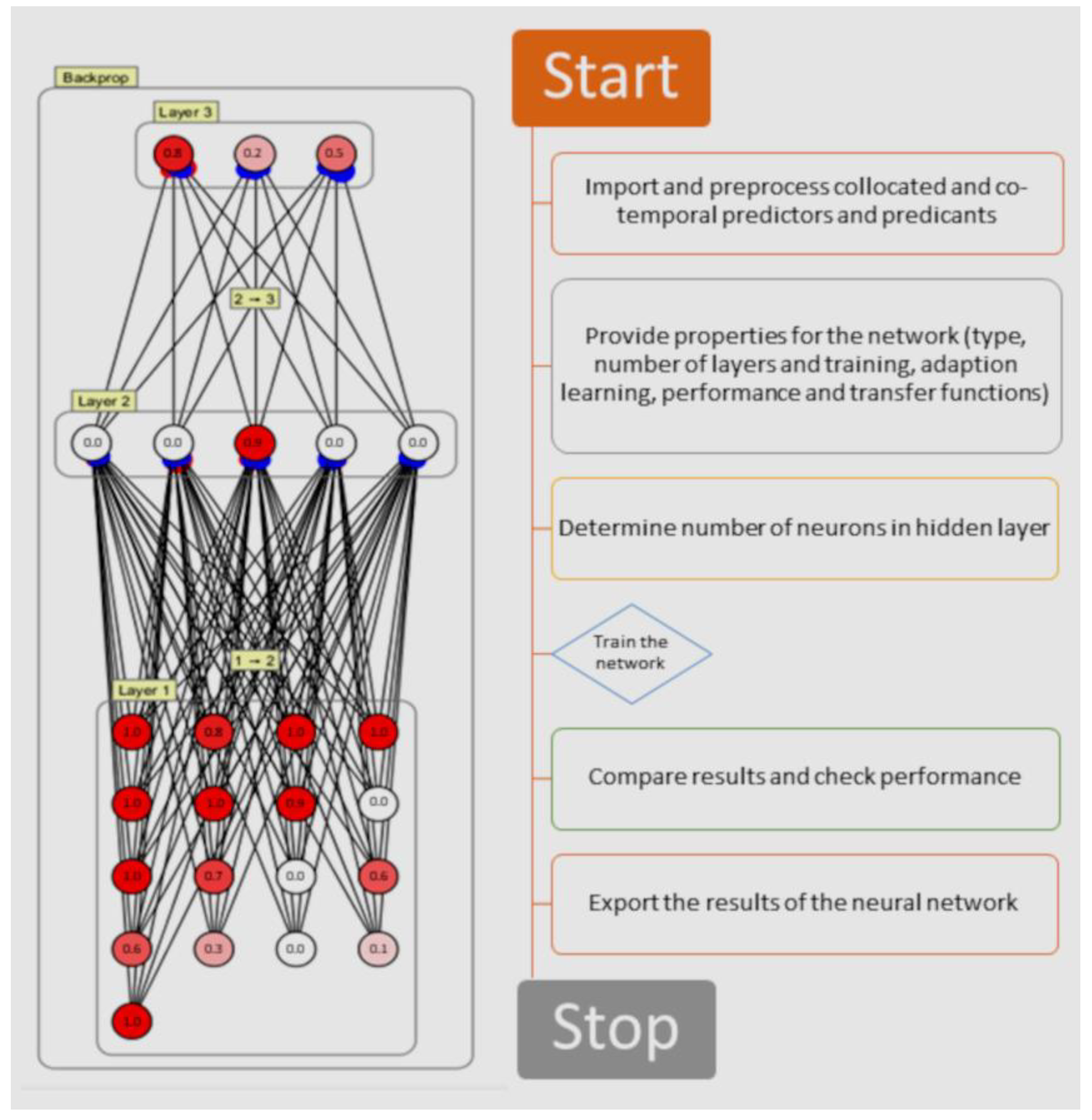


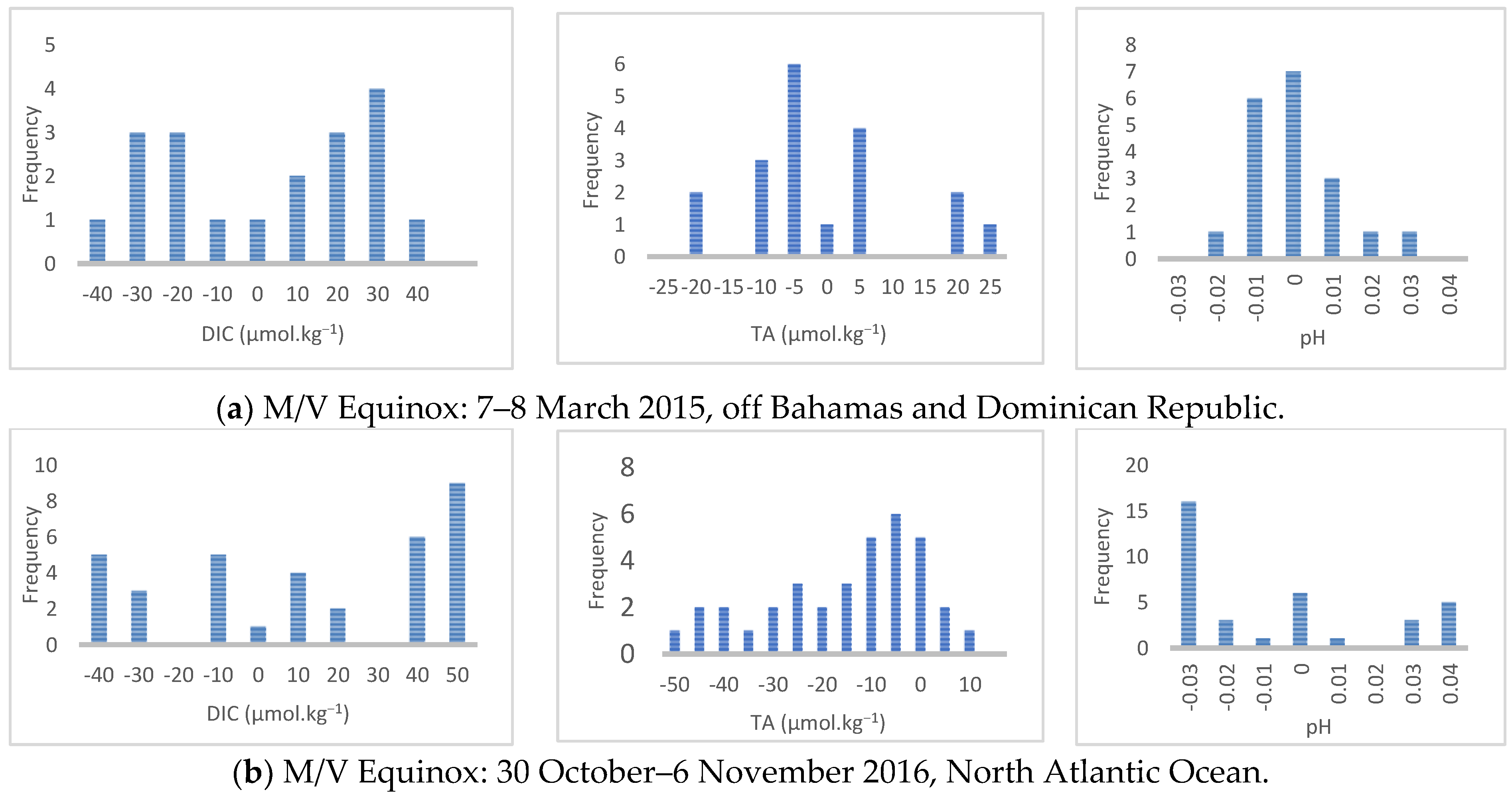
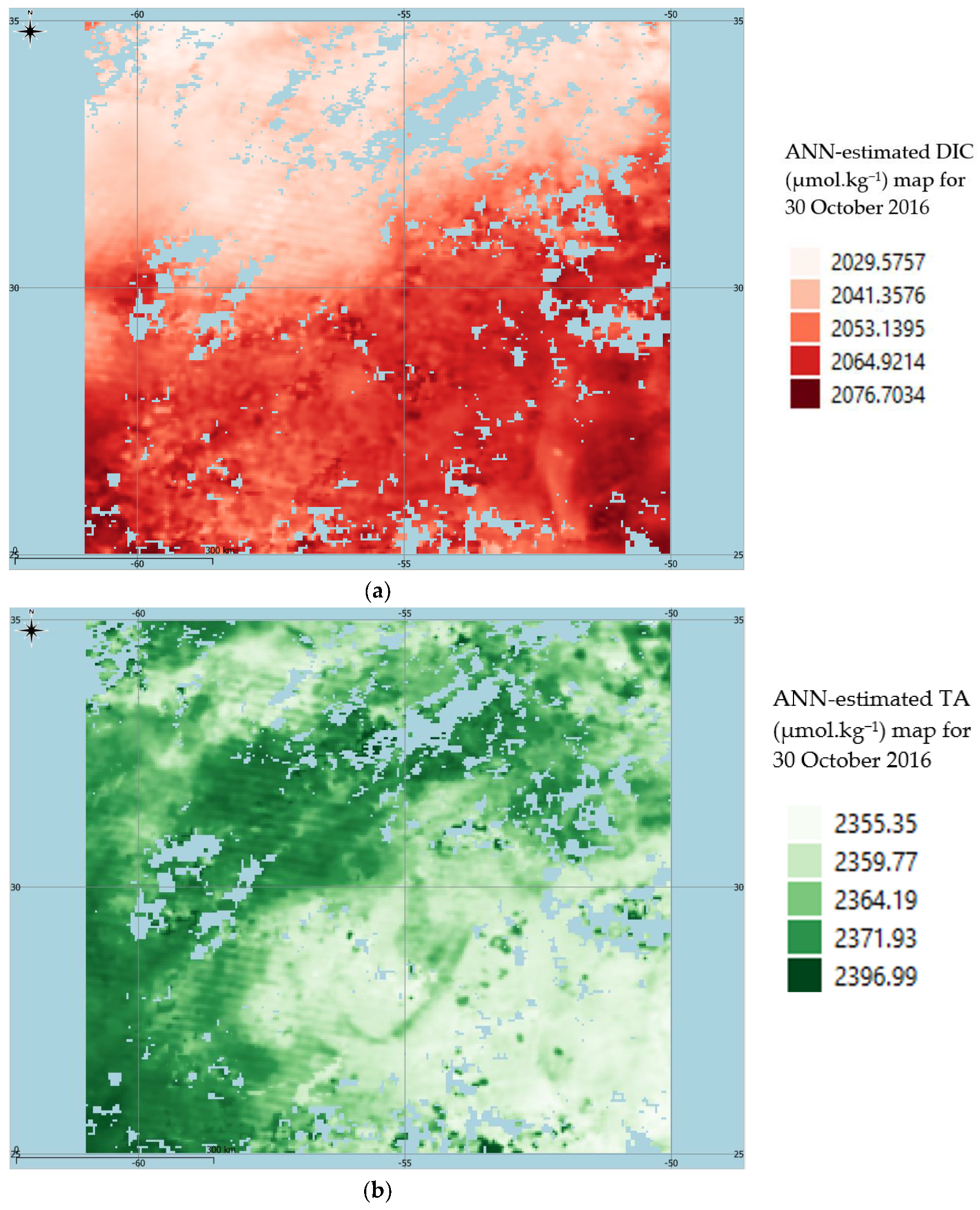
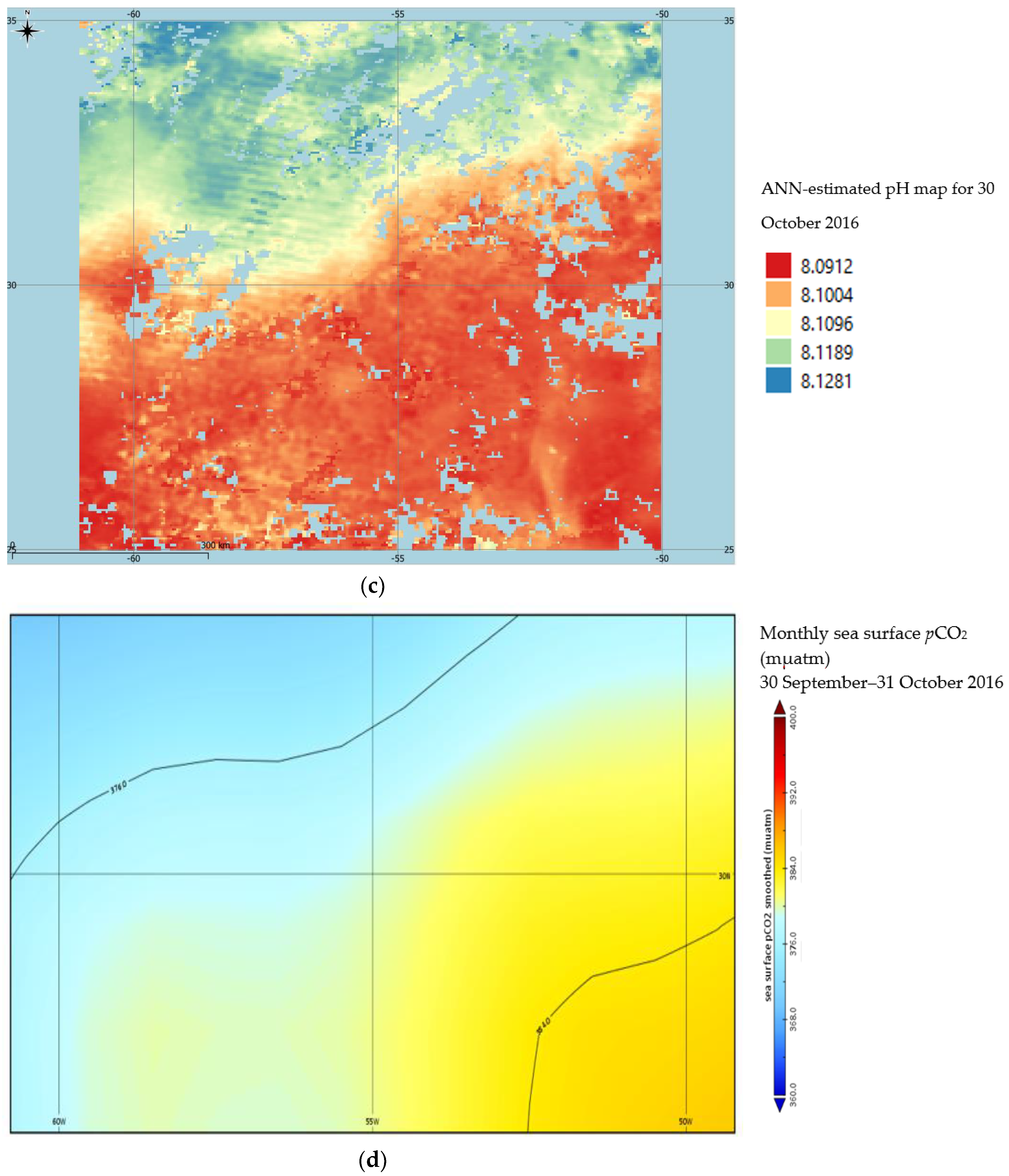


| Parameter | Range | Δ |
|---|---|---|
| SST (°C) | 15.2–27.5 | 12.3 |
| SSS (PSU) | 35.46–36.95 | 1.49 |
| DIC (μmol.kg−1) | 2025–2126 | 101 |
| TA (μmol.kg−1) | 2350–2439 | 89 |
| pH | 7.964–8.142 | 0.178 |
| Parameter | Code | Source | Resolution | Reference |
|---|---|---|---|---|
| Biological drivers | ||||
| Water-leaving surface reflectance (Rrs) at 412, … 555 nm) | BD 1 | MODIS (Aqua, Terra) | 0.042°, daily, global | [24,25] |
| Rrs 443/555 | BD 2 | MODIS (Aqua, Terra) | 0.042°, daily, global | [24,25] |
| Rrs 531/555 | BD 3 | MODIS (Aqua, Terra) | 0.042°, daily, global | [24,25] |
| Rrs 443/488 | BD 4 | MODIS (Aqua, Terra) | 0.042°, daily, global | [24,25] |
| Chlorophyll-a | BD 5 | MODIS (Aqua, Terra) | 0.042°, daily, global | [26] |
| Particulate Inorganic Carbon (PIC) | BD 6 | VIIRS | 0.042°, daily, global | [27] |
| Particulate Organic carbon (POC) | BD 7 | VIIRS | 0.042°, daily, global | [28,29] |
| Physical drivers | ||||
| Sea surface salinity | PD 1 | SMOS | 0.05°, daily, global | [30] |
| Sea surface temperature | PD 2 | OISST | 0.25°, daily, global | [26] |
| Wind speed | PD 3 | ASCAT | 0.25°, daily, global | [26] |
| Wind direction | PD 4 | ASCAT | 0.25°, daily, global | [26] |
| Wind stress | PD 5 | ASCAT | 0.25°, daily, global | [31] |
| Transfer velocity (W) | PD 6 | Based on ASCAT | 0.25°, daily, global | [32] |
| Transfer velocity | PD 7 | Based on ASCAT | 0.25°, daily, global | [33] |
| Transfer velocity | PD 8 | Based on ASCAT | 0.25°, daily, global | [34] |
| Bathymetry | PD 9 | GEBCO | 0.083°, global | [35] |
| Mean layer depth | PD 10 | Global ocean 1/12° physics analysis and forecast updated daily. Copernicus marine environment monitoring service. | 0.083°, daily mean, global analyses, 50 depth levels | [36,37] |
| Environmental Driver | Summary | Reference |
|---|---|---|
| Transfer velocity | The transfer velocity describes the efficiency exchange of CO2 across the air–sea interface and dissolution in water on the basis of ΔpCO2 between the water and the atmosphere. | [32,33,34,39,40,41,42,43,44,45] |
| Wind speed (U10) and direction (DD) | The wind speed determines the structure and fluxes at the air–sea interface. It has an important effect on the magnitude and direction of the CO2 flux across the air–sea interface, which differs according to the prevalent wind and turbulence regimes. | [46,47,48,49,50,51,52,53] |
| Mean layer depth | This is the depth at which the density difference from the surface reaches 0.02 kg m−3. Within this layer, the properties of density, temperature, and salinity are more uniform, due to the mixing. When this layer is well-defined, a significantly enhanced transfer velocity within it is observed. | [36,37,54,55,56,57] |
| Wind stress | Wind stress is able to affect the vertical transport of dissolved gases, such as CO2. | [31] |
| Sea surface salinity | Sea surface salinity has been used as a proxy indicator for pCO2 using statistical analysis and artificial neural networks. CO2 solubility is a function of temperature and salinity. | [31,58,59,60,61] |
| Sea surfacetemperature | Sea surface pCO2 depends on the SST, such that when the SST increases by 1 °C, the surface pCO2 increases 4-fold. | [26,62,63,64,65,66,67,68] |
| Depth | The depth and structure of the sea bottom can influence the intensity of upwelling. High levels of CO2 from deep water can be brought to the surface through upwelling and released into the atmosphere. This can be enhanced in the case of an existing deep-water circulation. | [69] |
| Biological activity | Photosynthesis acts to bind CO2 into organic matter and can affect DIC concentration. Studies show that chlorophyll-a correlates well with pCO2. | [26,67,70] |
| Particulate Organic carbon (POC) | POC is a proxy of coccolithophore production, which in turn is often used as a measure of net productivity. The phenomenon of sinking POC is part of the biological pump, which provides a mechanism for the sequestration of carbon in the deep ocean. | [25,71] |
| Particulate Inorganic Carbon (PIC) | PIC is used as a measure of net calcification by coccolithophores. The PIC:POC ratio is considered to be an important term for modeling carbon cycling in the oceans and, therefore, is a good indicator of changes in seawater CO2. | [72,73,74] |
| Sampling Period | Pearson Correlation R–Sea Surface Temperature | Pearson Correlation R–Sea Surface Salinity |
|---|---|---|
| 7–8 March 2015 | 0.78 | 0.93 |
| 28 April–6 May 2015 | 0.99 | 0.69 |
| 16–24 April 2016 | 0.98 | 0.90 |
| Discrete Underway Measurements | ANN Estimation | Mean Bias | |||||||
|---|---|---|---|---|---|---|---|---|---|
| StationID | DIC (μmol·kg−1) | TA (μmol·kg−1) | pH | DIC (μmol·kg−1) | TA (μmol·kg−1) | pH | TA (μmol·kg−1) | DIC (μmol·kg−1) | pH |
| 1120000 | 2074 | 2387 | n/a | 2064 | 2385 | 8.111 | 10 | 2 | n/a |
| 1130000 | 2078 | 2397 | n/a | 2066 | 2378 | 8.105 | 12 | 19 | n/a |
| 1140000 | 2076 | 2404 | n/a | 2071 | 2368 | 8.099 | 5 | 36 | n/a |
| 1150000 | 2081 | 2400 | n/a | 2066 | 2375 | 8.104 | 15 | 25 | n/a |
| 1160000 | 2083 | 2392 | n/a | 2062 | 2384 | 8.112 | 21 | 7 | n/a |
| 1200000 | 2078 | 2382 | 8.073 | 2075 | 2378 | 8.096 | 3 | 4 | −0.023 |
| 1330000 | 2095 | 2390 | 8.073 | 2073 | 2388 | 8.099 | 21 | 1 | −0.025 |
Disclaimer/Publisher’s Note: The statements, opinions and data contained in all publications are solely those of the individual author(s) and contributor(s) and not of MDPI and/or the editor(s). MDPI and/or the editor(s) disclaim responsibility for any injury to people or property resulting from any ideas, methods, instructions or products referred to in the content. |
© 2023 by the authors. Licensee MDPI, Basel, Switzerland. This article is an open access article distributed under the terms and conditions of the Creative Commons Attribution (CC BY) license (https://creativecommons.org/licenses/by/4.0/).
Share and Cite
Galdies, C.; Guerra, R. High Resolution Estimation of Ocean Dissolved Inorganic Carbon, Total Alkalinity and pH Based on Deep Learning. Water 2023, 15, 1454. https://doi.org/10.3390/w15081454
Galdies C, Guerra R. High Resolution Estimation of Ocean Dissolved Inorganic Carbon, Total Alkalinity and pH Based on Deep Learning. Water. 2023; 15(8):1454. https://doi.org/10.3390/w15081454
Chicago/Turabian StyleGaldies, Charles, and Roberta Guerra. 2023. "High Resolution Estimation of Ocean Dissolved Inorganic Carbon, Total Alkalinity and pH Based on Deep Learning" Water 15, no. 8: 1454. https://doi.org/10.3390/w15081454






